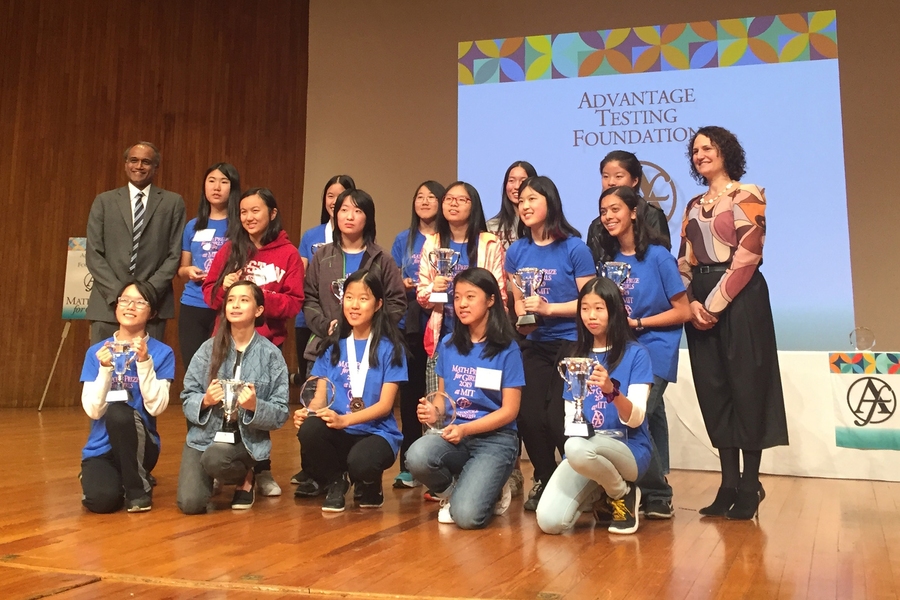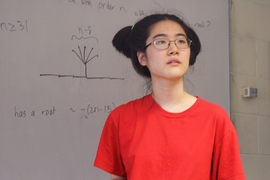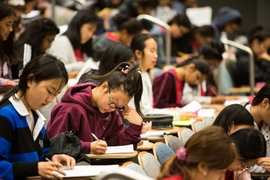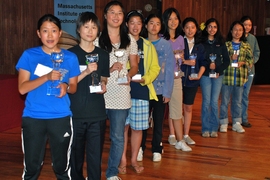Three young women are throwing questions, rapid fire, at Ken Fan PhD ’95, the founder of Girl’s Angle, a non-profit mathematics club for girls.
“Is it rational?”
“No.”
“Is it transcendental?”
“Yes.”
“Is it pi?”
“No.”
“Is it e?”
“No.”
“Is it some combination of pi and e?”
“Too vague.”
They’re trying to solve a collaborative puzzle created by Fan, and one of the steps involves asking him yes-or-no questions in order to figure out the number they need for the next step. After a few tries, they’ve got it (it’s -e/2), and they return to the rest of the group working to find the combination for the locked box that contains their prize. According to Fan, the prize is a bag of candy, but he hopes the girls will take something else away from the game: an understanding that math is collaborative and fun.
Playing 20 questions
The girls are some of the 268 middle and high school math enthusiasts who descended on campus the weekend of Oct. 12-13 for the Math Prize for Girls event. The mathematics competition, hosted at MIT for the ninth time, is the world’s largest math prize for young women high school age or younger. On Sunday, they settled into their seats to solve 20 math questions, but the night before they bonded over cake and games.
Game night happened in the Lobdell Dining Hall in the Stratton Student Center (Building W20) with activities designed to integrate the contestants. At one end of the dining hall, Meena Boppana, a longtime volunteer of Math Prize, guided a speed-dating-style get-to-know-you station, in which contestants and alumnae of the program could become quickly acquainted. Throughout the hall, sitting at tables or on the floor, contestants put together red, 3D rhombic hexecontahedron puzzles, then stacked these into tall towers. At another station, Jeannine Mosely PhD ’84, a software engineer at Akamai Technologies, demonstrated how to create one of her curved-edge origami designs.
For Maria De Vuono-Homberg, the associate director of Math Prize for Girls, the focus on community building is what makes this competition special. “Out of almost 300 girls, maybe 10 will get a trophy, another 25 will get an honorable mention, but that’s not why they’re here,” says De Vuono-Homberg. “They’re here to spend time together.”
“I like it because it’s bringing together a lot of people with similar interests and backgrounds. And it’s all girls, which is not something you see all the time,” says one contestant from Canada. “When you think of how many different places these people are coming from, it’s just really nice,” she adds.
According to De Vuono-Homberg, when contestants fill out the post-competition survey, they highlight the importance of being surrounded by people who share their love of math. And for her, that’s the whole point of the competition. “At Math Prize, your right to belong is never questioned,” says De Vuono-Homberg.
Growing a supportive network
Math Prize for Girls was started 11 years ago by Ravi Boppana PhD ’86, a research affiliate in the Department of Mathematics, and Arun Alagappan, the founder of Advantage Testing, to address the gender gap in math. Inspired by their daughters — Boppana has one (longtime volunteer Meena), and Alagappan has three — they created the competition to celebrate girls’ love of math and to build a community of alumnae that encourage women to pursue math. “Ravi and I founded Math Prize, knowing that as long as they were supported, women would persevere,” said Alagappan at the award ceremony.
Justina Yang ’19, attended Math Prize for Girls for four years when she was in high school, but it was when she became an alumna volunteer that she realized the importance of the supportive network it builds. “Over the past few years, I’ve grown to really enjoy and value talking to people who come to Math Prize,” she says. For Yang, one of the reasons she continues to volunteer at Math Prize is the hope that she can be of use to the contestants, many of whom are applying to college and figuring out their next steps.
Throughout the competition, the collaborative nature of math was highlighted. “We know that math is inherently collaborative,” says Alagappan, with breakthroughs coming from teams and through colleagues that help mathematicians approach problems in new ways. Giving the Maryam Mirzakhani Keynote Lecture — named in honor of Mirzakhani, the first woman to win the Fields Medal — Gigliola Staffilani, the Abby Rockefeller Mauze Professor of Mathematics, compared mathematical proofs to a pile of laundry. “When I look at a problem, it’s like a pile of laundry — it’s a mess,” she says. But as each small item is folded, the problem becomes clearer. “And then there are the big things, like sheets, for which you need help, and that involves collaboration,” Staffilani explains.
After Staffilani’s keynote lecture, the top 10 awards were listed. The first prize, with 14 out of 20 questions answered correctly, went to Jessica Wan, an 8th grader from Puerto Rico, who also received the Youth Prize, which is awarded to the highest-scoring contestant in 9th grade and below. A full list of the winners and honorable mentions can be found at the Art of Problem Solving website.
As contestants collected their bags and said their goodbyes, the words of Emma Kerwin ’19, Math Girls alumna and awards ceremony emcee, went with them: “We are proud of you, we believe in you, and we truly expect great things from you.”









